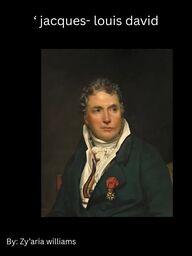
Return to flip book view
Message ‘ jacques- louis davidBy: Zy’aria williams
Summary of his life:Jacques-louis david was born on august30, 1748, in paris, france. He grew up ina wealthy family, but his childhoodchanged after his fahter died in a dualwhen david was young. This led him tospend most of his early life living withrelatives. As a kid, david was quiet andloved drawing more than schoolwork,which eventually pushed him towardart. He trained with famous painters inparis and later studied in rome, wherehe fell in love with the styles of ancientgreece and rome.
Introduction to hisstyle: neoclassicismJacques-louis david was one ofthe most important artists of theneoclassical movement. Hisartwork used very clear lines,strong lighting, and calm,serious faces to show disciplineand moral strength. He wasinfluenced by ancientsculptures, and renaissance art.
6 important artworks:Oath of the horatii (1784):Location: The louvre museum, paris
The dealth of socrate (1787):Located: metropolitionmeauseam of art, new york
The lictors bring brutus of thebodies of his sons (1789) :Location: louvre museam,paris
Napoleon crossing the alps (1801)Location: charlottenburg palace,berlin
The coronation of napoleon (1805-1807)Location: louvre museam, paris
The death of marat (1793) Location: royal museams of fine arts,brussels
My two favorite artworks:The death of socrates: I like this artworkbecause it shows strength, courage, andcalmness even in a difficut moment. Theclear lighting and strong lines make thescene feel powerful. Napoleon crossing the alps: I like thisartwork also because it shows power.And it represents how david wanted toshow leaders as bold and confident.